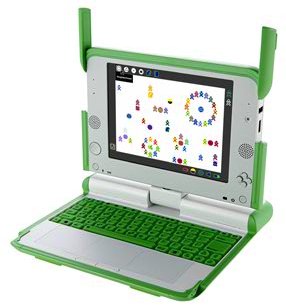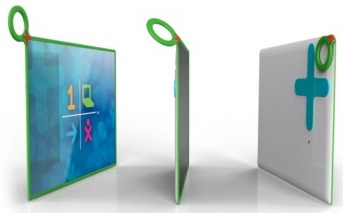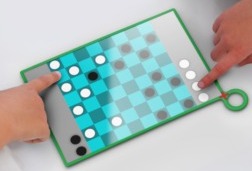OLPC tablet prototype unveiled
Dec 23, 2009 — by Eric Brown — from the LinuxDevices Archive — 1 viewsOne Laptop Per Child unveiled a roadmap for its Linux-ready XO netbooks, and confirmed it will deliver a Marvell/ARM-based XO-1.75 version in early 2011, says eWEEK. OLPC also released images of a prototype XO-3 tablet due in 2012, costing under $100, and made of a single sheet of plastic.
The non-profit One Laptop Per Child (OLPC) organization is devoted to seeding its low-cost XO netbooks around the world for schoolchildren in developing nations. According to the most recent figures from OLPC, the XO has been distributed to more than 1.4 million children in 35 countries, according to a Jeffrey Burt story in our sister publication, eWEEK.

OLPC's XO 1.5

XO-3 prototype
OLPC apparently did not reveal which Marvell CPU it was considering, but Marvell recently announced a line of Armada system-on-chips (SoCs) based on its Sheeva PJ1 architecture and ARMv5 instruction set. Last year, the company released a Sheeva/ARM-based Marvell 88F6000 "Kirkwood" SoC capable of scaling to 2GHz, which was later used in Marvell's popular, Linux-based SheevaPlug Plug Computer design.
The XO-1.5 will be followed by the ARM-based XO-1.75 model in early 2011, selling for under $150, says eWEEK. This model will also stay with the basic XO design, but will include rubber bumpers on the outside, move to a touchscreen interface, and offer an 8.9-inch display, up from 7.5 inches. The new system will offer twice the speed of the XO-1.5, and consume a quarter of the power, says the story.
 Negroponte had hinted at a shift from xPC to ARM in March, but at the time suggested that the ARM SoC might go in the planned XO-2, an early prototype of which (pictured at right) had been demonstrated in September of last year. However, OLPC has now scrapped that ambitious, dual-screen design, and instead will jump directly from the XO-1.75 to the XO-3 (pictured below) in 2012.
Negroponte had hinted at a shift from xPC to ARM in March, but at the time suggested that the ARM SoC might go in the planned XO-2, an early prototype of which (pictured at right) had been demonstrated in September of last year. However, OLPC has now scrapped that ambitious, dual-screen design, and instead will jump directly from the XO-1.75 to the XO-3 (pictured below) in 2012.
Negroponte had also tipped the XO-3 last month, but has now filled in a few more details, including photos of prototypes. Based on the same ARM processor as the XO-1.75, the XO-3 is built from a single sheet of flexible plastic, and designed to be unbreakable, says eWEEK. Free of noticeable buttons, the prototype sports a rubber ring attached to the upper right corner to make it easier to hold and carry, says the story.

Different views of the XO-3

The XO-3 may be laid flat to play games
As for manufacturing details for the XO-3, Forbes further quotes Negroponte as saying. "We don't necessarily need to build it. We just need to threaten to build it."
Indeed, Negroponte's original goal for the XO was not to start a computer company, but to encourage PC users to develop lower cost computers for the developing world. While OLPC has had its troubles over the year, and has fallen short of its goals, the XO did inspire Asus and other PC vendors to develop their own commercial netbooks.
Netbooks are now the fastest growing segment of the computing industry, with sales driven in large part by consumers in poorer nations. This fact has helped to push up Linux netbook share to over 30 percent, according to ABI Research.
Availability
More information on the XO laptops may be found at OLPC's site, here. Concept images of the XO 3.0 design were here, but by presstime, the link was no longer working.
The eWEEK story on the XO announcements may be found here. The Forbes story may be found here.
This article was originally published on LinuxDevices.com and has been donated to the open source community by QuinStreet Inc. Please visit LinuxToday.com for up-to-date news and articles about Linux and open source.